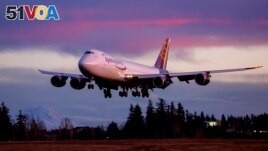31 January 2023
Boeing has manufactured its last 747 jet airplane. The move ends the long production history of one of the company's most popular aircraft.
The aerospace company built the last 747 for American-based airline Atlas Air. The plane was delivered to the company on Tuesday. The final 747 was the 1,574th one manufactured by Boeing at its production center in the state of Washington. Thousands of employees were expected to take part in a ceremony for the airplane.
Boeing completed the first 747 in 1969. The aircraft has served as a supply plane, an airliner with the ability to carry nearly 500 passengers and a transport plane for space shuttles. The 747 also serves as Air Force One, the official aircraft for the president of the United States.

The final Boeing 747 lands at Paine Field following a test flight, Tuesday, Jan. 10, 2023, in Everett, Wash. (Jennifer Buchanan/The Seattle Times via AP)
The plane revolutionized travel by connecting international cities that had never been directly linked before. Its ability to carry many passengers meant more people could travel by air.
But over the past 15 years, Boeing and its European competitors have launched their own versions of large planes that are more profitable and use less fuel. The newer aircraft also have just two engines instead of the 747's four.
"If you love this business, you've been dreading this moment," said longtime airline expert Richard Aboulafia. He added that the end of 747 production clearly demonstrates that "nobody wants a four-engine airliner anymore." However, Aboulafia said it should not be forgotten that for many years, the 747 had a major influence on the development of the airline industry.
Boeing approved production for the 747 after losing a contract for a huge military transport plane, the C-5A. The idea was to put new, powerful engines designed for transport aircraft into planes designed to carry passengers.
It took Boeing workers less than 16 months to complete the first 747. The major effort ended up earning the manufacturing team a nickname called "The Incredibles." The plane's production required a huge factory in Everett, Washington. It is still the world's biggest building by volume.
The body of the aircraft, known as the fuselage, measured about 69 meters long. The tail was as tall as a six-story building. The design included a second level that extended upward over the first third of the plane. Some airline companies turned the second level into a first-class sitting area.
The large, new plane model became known as the "Queen of the Skies."
"It was the first big carrier, the first wide-body. So, it set a new standard for airlines to figure out what to do with it, and how to fill it," said Guillaume de Syon. He is a history professor and airline expert at Pennsylvania's Albright College.
Delta was the last U.S. airline to use the 747 for passenger flights, which ended in 2017. Some international carriers continue to use the plane to transport passengers, including Germany's Lufthansa.
Atlas Air ordered four 747-8 models early last year and the final one left Boeing's factory on Tuesday.
Boeing's relationship with the Federal Aviation Administration has been strained since deadly crashes of its best-selling plane, the 737 Max, happened in 2018 and 2019.
The FAA took nearly two years – far longer than Boeing expected – to approve design changes and permit that plane back in the air.
I'm Bryan Lynn.
The Associated Press and Reuters reported on this story. Bryan Lynn adapted the reports for VOA Learning English.
____
Words in This Story
deliver –v. to bring something to a person or place
dread – v. to feel worried or frightened about something that has not yet happened
nickname – n. a name used informally instead of a person's real name
standard – n. a level of quality, especially a level that is acceptable
first-class –adj. the best or highest level of something
strain – v. to cause problems for a situation or relationship










